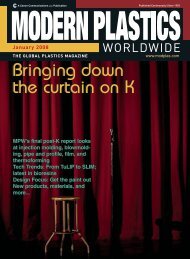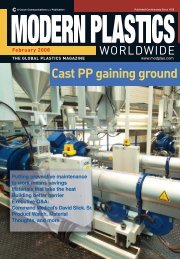Modern Plastics Worldwide - October 2007 - dae uptlax
Modern Plastics Worldwide - October 2007 - dae uptlax
Modern Plastics Worldwide - October 2007 - dae uptlax
Create successful ePaper yourself
Turn your PDF publications into a flip-book with our unique Google optimized e-Paper software.
MODERN EXECUTIVE<br />
Long-term testing critical for material<br />
selection<br />
By Chris O’Connor<br />
More than 5000 plastic product failures<br />
have been the subject of study<br />
at Smithers Rapra Technology. These<br />
have been classified on the basis of primary<br />
failure mode as shown in Figure 1.<br />
A further breakdown of plastics product<br />
failure due to human causes is given in<br />
Figure 2, with 45% due to poor material<br />
selection and poor specification.<br />
Failures due to poor material selection<br />
appear related to a lack of awareness<br />
and understanding of plastics properties.<br />
When considering the design and<br />
development of a plastic component, it is<br />
imperative that designers and engineers<br />
fully understand the fundamental nature<br />
of plastics. They should know that plastics<br />
are non-linear, visco-elastic materials<br />
with temperature/time-dependant properties.<br />
<strong>Plastics</strong> physically and chemically<br />
age, and are susceptible to chemical<br />
attack, environmental stress cracking<br />
(ESC), and weathering.<br />
<strong>Plastics</strong> eventually fail under tensile<br />
stress, with the time to failure diminishing<br />
as the stress or temperature (or both)<br />
increases, in the presence of certain environments,<br />
or under cyclic loading.<br />
Designers need to know that weld lines<br />
result in planes of weakness, particularly<br />
in fiber-reinforced materials. In fact, the<br />
addition of any form of filler will always<br />
have some form of detrimental effect on<br />
a material. <strong>Plastics</strong> can show mechanical<br />
anisotropy due to the alignment of fiber<br />
reinforcement.<br />
Breaking it down<br />
To logically approach material selection,<br />
the basics of polymer structure and polymer<br />
properties must be considered. The<br />
three main polymer groups are thermoset<br />
plastics, thermoplastics, and elastomers.<br />
Correct material selection is a critical factor in eliminating warranty and recall<br />
risk in plastic products and components. Here is a primer for some, and a<br />
reminder for others, on some of the basic and not-so-basic points of plastics<br />
selection.<br />
There are also two<br />
basic types of thermoplastic:amorphous<br />
and semicrystalline.<br />
Amorphous plastics<br />
have no ordered<br />
structure, whereas<br />
semicrystalline plastics<br />
have areas of<br />
order, which form<br />
crystallites. In general,<br />
amorphous plastics<br />
exhibit better<br />
creep resistance (constant<br />
static load over<br />
time) whereas semicrystalline<br />
materials<br />
offer better fatigue,<br />
chemical, and environmental<br />
stress<br />
cracking (ESC)<br />
resistance.<br />
Amorphous plastics<br />
are best used<br />
where transparency<br />
is important and low<br />
levels of mechanical<br />
abuse and chemical<br />
contact are expected.<br />
Semi-crystalline materials are a good bet<br />
when resistance to chemicals/ESC,<br />
mechanical abuse and cyclic loading is<br />
required.<br />
Designers and engineers historically<br />
have worked with metals and other<br />
materials, which exhibit a predictable,<br />
linear elastic stress-strain relationship.<br />
But polymers’ visco-elasticity means they<br />
respond to stress as if they were a combination<br />
of elastic solids and viscous fluids,<br />
so that they exhibit a non-linear stressstrain<br />
relationship, and their properties<br />
Environmental stress cracking<br />
Notched static rupture<br />
Chemical attack<br />
Thermal degradation<br />
Dynamic fatigue<br />
Creep/relaxation<br />
UV attack<br />
Others<br />
Figure 1<br />
Material/phenomenological<br />
causes of failure<br />
depend on the time under load, temperature,<br />
environment and the stress or strain<br />
applied.<br />
When using Finite Element Analysis<br />
(FEA) for elastic materials such as metals,<br />
the software requests the modulus<br />
(stiffness) of the material. For metals the<br />
tensile modulus of the material is simply<br />
entered (depending on the loading scenario)<br />
and the FEA software calculates<br />
the result. When designing with elastic<br />
materials, designers and engineers can<br />
rely on instantaneous stress-strain prop-<br />
22 OCTOBER <strong>2007</strong> • MODERN PLASTICS WORLDWIDE modplas.com









